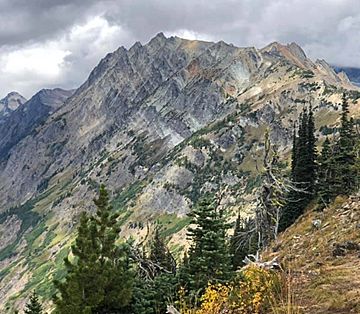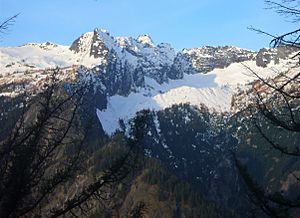Brahma Peak facts for kids
Quick facts for kids Brahma Peak |
|
|---|---|

Southeast aspect, from Little Giant Pass
|
|
| Highest point | |
| Elevation | 8,078 ft (2,462 m) |
| Prominence | 238 ft (73 m) |
| Isolation | 1.77 mi (2.85 km) |
| Parent peak | Buck Mountain |
| Geography | |
| Location | Chelan County, Washington, U.S. |
| Parent range | Cascade Range North Cascades |
| Topo map | USGS Clark Mountain |
| Type of rock | Schist |
Brahma Peak is a tall mountain in Washington state, part of the North Cascades mountain range. It stands about 8,078 feet (2,462 meters) high. This remote peak is located on Chiwawa Ridge in Chelan County.
Brahma Peak is found in a wild area called the Glacier Peak Wilderness. This land is looked after by the Wenatchee National Forest. Its closest taller neighbor is Buck Mountain, which is about 1.8 miles (2.9 km) to the north. Brahma Peak is on a long line of mountains called Chiwawa Ridge. Other important peaks on this ridge include Fortress Mountain and Chiwawa Mountain.
Water from Brahma Peak and its melting glaciers flows into the Chiwawa River and Napeequa River. Both of these rivers eventually join the Wenatchee River. The mountain's southwest side has steep, purple-colored cliffs made of Schist rock. These cliffs rise almost 4,000 feet (1,200 meters) above the Napeequa River Valley in just about one mile.
How the Mountains Formed
The North Cascades are known for their rugged landscape. They have sharp peaks, tall spires, long ridges, and deep valleys carved by glaciers. These amazing shapes were created by geological events that happened millions of years ago. These events caused big changes in elevation and led to different climates across the Cascade Range.
The Cascade Mountains began forming millions of years ago, during a time called the late Eocene Epoch. This happened because the North American Plate (a huge piece of Earth's crust) slowly moved over the Pacific Plate. This movement caused many volcanic eruptions. For example, Glacier Peak, a large cone-shaped volcano, started forming in the mid-Pleistocene period. It is about 9.8 miles (15.8 km) west-northwest of Brahma Peak.
Also, small pieces of Earth's crust, called terranes, came together to create the North Cascades about 50 million years ago.
During the Pleistocene period, which started over two million years ago, glaciers grew and shrank many times. As they moved, they scraped and shaped the land, leaving behind piles of rock. The "U"-shaped valleys you see in the rivers today were formed by these glaciers. There are still several glaciers on the slopes of Buck Mountain. The lifting of land (called uplift) and cracks in the Earth's crust (called faulting), along with glaciation, have been the main forces that created the tall peaks and deep valleys of the North Cascades.
Mountain Weather
Brahma Peak is in a marine west coast climate zone. This means it's near the ocean, which affects its weather. Most weather systems start in the Pacific Ocean and move northeast toward the Cascade Range.
When these weather systems reach the North Cascades, the tall mountains force the air upward. As the air rises, it cools and drops its moisture as rain or snow onto the Cascades. This process is called Orographic lift. Because of this, the western side of the North Cascades gets a lot of rain and snow, especially in winter.
Thanks to the mild ocean influence, areas west of the Cascade mountain crest rarely get extremely cold (below 0°F or -18°C) or very hot (above 80°F or 27°C). In winter, it's often cloudy. However, in summer, high-pressure systems over the Pacific Ocean become stronger, leading to clear skies. Because the snow is often wet and heavy due to the ocean's influence, there is a high risk of avalanches.




